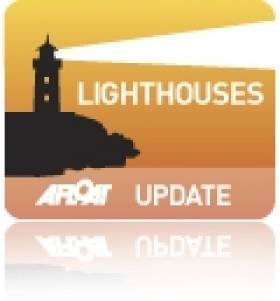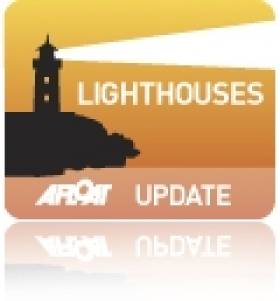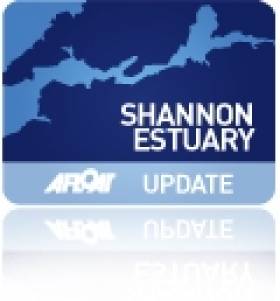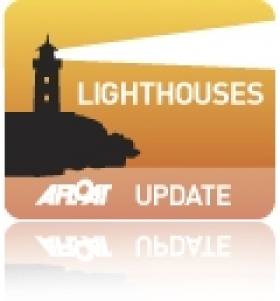Displaying items by tag: Irish Lights
International Peer Review Confirms Aids to Navigation Requirements for the Irish Coast to 2020
#lighhousereview – The General Lighthouse Authorities for the UK and Ireland have now completed their latest 5 yearly comprehensive review of Aids to Navigation (AtoN) requirements for the waters around Ireland and the United Kingdom. User Feedback, Automatic Identification System (AIS) traffic analysis, Targeted User Consultation, Navigational Significance Assessments, Risk Assessments and Peer Review were all used to help define ongoing User Requirements. The full document is downloadable below as a pdf document.
The following principles were applied during the review process to ensure consistency:
• Generally having one light in view is acceptable
• Generally a max range of 18 Nautical Miles is considered sufficient for most lights
• If practical there can be a reduction in amount and diversity of flash characters on lighthouse lights
• Leading Lights remain important
• Sectored Lights remain important
• Synchronised and Sequential Buoy lights can be used more
The decisions were made following consultation with users and representative organization's across the whole spectrum of the industry from large SOLAS vessels to leisure users and the fishing sector.
A summary of the changes that Irish Lights will make is as follows:
• Establish RACON at the Foyle Buoy due to increased large vessel traffic
• Open negotiations to upgrade to general AtoN status' Bloody Foreland Light as analysis has shown General Traffic is transiting the area
• Disestablish the Pollock Buoy as the Power South Cardinal has made this Buoy redundant
• Replace the Briggs Port Hand Buoy with a North Cardinal Buoy to provide a clearer indication of the position of the danger
• Establish a Buoy in place of the Unlit Carrigavadra Beacon
• Sequence Buoyage at the entrance to Rosslare
Capt. Harry McClenahan Navigation Manager at Irish Lights said "The rate of technological changes in navigation support systems and materials has had a significant and positive effect on the services that Irish Lights provides to the Mariner, allowing for higher performance yet lower power demands from our stations. We are in the embryonic phase of the evolution of digital systems which are already starting to shape the future of marine navigation and communications. To ensure that safety of persons and property and environmental protection remain as the main focus for future navigation services we use our resources, experience and competency to explore and trial new systems and materials."
The 2015 Aids to Navigation Review was launched yesterday at the Joint Users Consultative Group Meeting in Trinity House London. The changes will be phased in over the coming years and will be fully promulgated in advance by Notice to Mariners.
When Irish Lights Are Shining in the Scilly Isles
#IrishLightsScilly – ILV Granuaile, the Commissioners of Irish Lights aids to navigation tender is understood to have carried out work for the first time within waters of the Isles of Scilly, writes Jehan Ashmore.
The tender's call in this week of St. Patrick's Day followed a departure from Irish waters in which she has responsibility around the entire coast of this island.
It was when she headed through St. Georges Channel is where she passed in the opposite direction the containership Coronel. The only vessel that operates between the Irish and Welsh capitals had departed Cardiff bound for Dublin.
ILV Granuaile has worked previously off the UK's South West coast but prior to this area she headed into the Bristol Channel to call into Swansea Docks where Trinity Lights have a depot in King's Dock. Likewise of Irish Lights, the general lighthouse authority (GLA) of Trinity House has responsibility for the safety of shipping and mariners in waters off England, Wales and the Channel Islands.
Following an overnight call, she was off Porthcawl. She then took a longer passage across the Bristol Channel to pass off Ilfracombe and offshore of the estuary leading to Appledore. This is where the Navy Service latest newbuild OPV90 was built by Babcock Marine. As reported before, James Joyce had completed recent builders sea-trials.
So why was ILV Granuaile working off the Scilly Isles, the reason is that one of the trio of Trinity House vessels, THV Patricia is undergoing her special five-year drydock in Hull. Last year ILV Granuaile underwent a more extensive 15 year Special Survey and Drydocking' at Cork Dockyard.
During her Scilly stay and offshore of Hugh Town on the largest island is where the main freight-only cargship, Gry Maritha was operating.
Both vessels this afternoon departed for the mainland, with the cargoship calling within the small confined dock of Penzance Harbour. Whereas the Irish lighthouse tender took up a position offshore of the Cornish port.
In January, Northern Lighthouse Board, the third GLA, deployed NLB Pole Star that involved a brief call to Dun Laoghaire Harbour. The call of the tender which otherwise has juristriction along with NLB Pharos of Scottish and Manx waters was concurrent to the 'Granuaile' making a more recent call to Cork Dockyard last month.
Second 'Spar' Trial Buoy Deployed on The Irish Sea
#SPARbuoys – The second of a pair of Finnish Spar tube type buoys has been deployed by the Commissioners of Irish Lights at the Bennet Bank station on the outer fringes of Dublin Bay,writes Jehan Ashmore.
ILV Granuaile, the aids to navigation tender carried out the deployment on Tuesday, a day after the first Spar buoy (a type used in the Baltic Sea) was deployed further south in the Irish Sea at the West Blackwater station off the Wexford coast.
CIL in co-operation with Meritaito Ltd, a Finnish state company are carrying out a comparison programme for performance and survivability tests on the spar buoys at the two Irish Sea stations and which are part of the Dublin Bay Digital Diamond Project.
The slim profile of Spar buoys, are particularly well suited to the Baltic's ice conditions, though they can suffer from conspicuity problems when compared with conventional buoys.
By deploying the Spar buoys, the Irish Sea trials will determine visible and radar conspicuity performance of the slimmer spar structures in comparison to the profile of the existing conventionally shaped buoys.
Trails are expected to run for 12 months and mariners are advised to maintain a safe distance from these buoys during the trial timeframe.
The Spar buoys are of the same light and daymark display as those of the existing buoys will be established in close proximity to both of the Irish Sea stations.
To consult the Notice to Mariners, showing Spar buoys locations, CLICK HERE.
Commissioners of Irish Lights Chart First Permanent Virtual Aid to Navigation in Irish Waters
#lighthouses – The Commissioners of Irish Lights (CIL) has the first permanent Virtual Aid to Navigation charted in Irish Waters on the 5th June 2014. The port hand Virtual Aid to Navigation was established at the entrance to Belfast Lough on the North East Coast of Ireland. This was in response to a newly reported shoal depth of 8.0 metres at the Rigg Bank.
CIL explored various options to ensure the shoal depth was addressed correctly. One option was to place a buoy to mark the pinnacle depth. However, after completing a Risk Assessment and extensive Automatic Identification System (AIS) analysis, it was clear the buoy would introduce a new danger in the relatively deep water. As a result, the port hand Virtual Aid to Navigation was chosen and deployed approximately half a nautical mile east of the position of the new pinnacle depth on the 20th November 2013.
Deirdre Lane, Navigation Policy Officer in CIL commented "It was found that deep draft vessels which need to have the pinnacle depth highlighted the most, are those that have the capability for a Virtual Aid to Navigation to be displayed on their on-board systems. In this unique set of circumstances, it was clear the Virtual Aid to Navigation was the best option".
One of the functionalities of AIS is that a land based AIS station can be used to transmit the position of an AIS Aid to Navigation that does not physically exist in the water. It is represented as a digital symbol on the ships Radar, Electronic Display and Information System (ECDIS) or Integrated Navigation System.
In order to bring the Virtual Aid to Navigation to the Mariners attention, it was officially mapped on navigational charts by the UKHO at CIL's request on 5th June 2014. As a result, CIL is responsible for the first permanent charted Virtual AIS Aid to Navigation in Irish waters.
Former Irish Lights Dun Laoghaire Harbour Based Buoy-Tender Sports New Shannonside Colours
#BuoyTender - Puffin, a former Commissioners of Irish Lights (CIL) buoy-tug tender which spent a career of almost three decades in Dun Laoghaire Harbour has recently been spruced up in new colours for current owners Shannon Workboats, writes Jehan Ashmore.
Puffin was very much a 'workhorse' for Irish Lights Dun Laoghaire based marine depot from where the vessel towed countless buoys back and forth to the various anchored 'lighthouse' tenders among them Atlanta, Granuaile and Gray Seal.
Arguably such workhorses can be easily forgotten or disregarded in a task perhaps perceived as mundane yet the role of the Puffin was an integral component in ensuring the operations of CIL.
The work of Puffin was vital bearing in mind the countless aids to navigation that dot around our island to assist safe passage not just to seafarers and ship cargoes but also passengers and leisure users too.
The Commissioners had Puffin custom-built from David Abels Boatbuilders of Bristol in 1984. It is understood that the small vessel of 12.4m long, beam of 3.8m and 1.5m draught was the last vessel launched from the Albion Dockyard.
When she was sold in 2011, the 24 gross tonnes vessel made her repositioning delivery voyage from Dun Laoghaire to the Shannon Estuary. The first leg to Baltimore took more than 30 hours and from where she took on bunkers before continuing on the final 20 hour-leg to Foynes.
She alongside Shannon Workboats fleetmate Islander are 'lines-boats' contracted to Rusal Aughinish Alumina, the largest alumina processing plant in Europe. Both workboats provide assistance in transferring mooring ropes between bulk-carriers docking and departing the double berth jetty.
The outer 285m berth can handle 90,000dwt vessels at depths of 12.4 metres and the inner 180m berth is for 40,000dwt ships in waters of 11 metres.
Examples to the type of bulk-carriers both large and small calling to Aughinish Jetty as previously reported on Afloat.ie are the 2009 Japanese built Panama-flagged Aom Julia, the 76,596dwt which was discharging bauxite. On the adjacent berth the South Korean built Arklow Mill of 14,990dwt was loading alumina bound for Rotterdam.
The plant's production process involves extracting alumina from imported bauxite that is discharged at the jetty. Approximately 70% of the bauxite originates from Guinea in west Africa and the balance from Brazil. The alumina (totalling 1.924m tonnes in 2012) is discharged from the same jetty for export where it is processed again through smelting into aluminium metal.
The lighthouse vessels are now referred as aids to navigation tenders with the current vessel the 2000-built ILV Granuaile. The 2,635 gross tonne vessel continues to anchor within the harbour's western bight off the West Pier. Instead of the Puffin, the towage of buoys continues to be maintained by smaller sized tenders belonging to the ILV Granuaile.
On a few occasions each year due to Spring tides, this procedure is not required as ILV Granuaile can moor alongside the berth at CIL's joint administration and marine depot.
Among the other tasks Puffin was gainfully employed was in the towage of the larger navigational aids such as Superbuoys and Large Automated Navigation Buoy's (LANBY). In 2010 Afloat.ie reported on the last LANBY.
In addition Puffin was not exclusively confined within the harbour as she would be required to transfer maintenance personnel to the automated Kish Lighthouse and Muglins lighthouse off Dalkey Island.
Her aft deck can handle up to 5–tonnes capacity and has proved useful. For example she loaded dismantled parts no longer required within the structure of the Kish Lighthouse and taken to Dun Laoghaire Harbour.
Puffin not only retains her original name but also her port of registry – Dun Laoghaire which is certainly most unusual to see for a vessel that is not a pleasure craft or yacht.
With the removal of Puffin's former CIL livery of grey hull colour and buff funnel, which also applied to the lighthouse tenders, the last been in this guise was the 1970 built Granuaile.The 2,003grt vessel as previously reported on Afloat.ie serves as Ocean Seeker for Gardline Marine Services based out of Great Yarmouth on the UK's Norfolk coast.
The current 'Granuaile' sports a blue hull likewise to her former fleetmate... the Puffin!
Irish Lights HQ To Welcome The Public For 'Open House Dublin'
#IrishLights - The headquarters of the Commissioners of Irish Lights in Dun Laoghaire is one of the 100 great buildings that will open to the public on the weekend of 4-6 October for Open House Dublin, the annual celebration of the city's architecture and history.
It seems fitting that the head office of the body that administers some of Ireland's most treasured coastal landmarks is itself an architectural wonder, a stunning rotunda of tinted glass ad steel designed by Scott Tallon Walker Architechts that's complemented the Dun Laoghaire waterfront since 2008.
Tours of the building will be on a first come, first served basis: just turn up and look out for Open House Dublin volunteers. See the Open House Dublin website for more.
Beaming Lights Locate All Ireland Lighthouse Trail
#LighthouseTrail - As previously reported last week the first ever All Ireland Lighthouse Trail was jointly launched by ministers from north and south at Blackrock Lighthouse, Co. Antrim, one of five lighthouses selected for development along the northern coastline.
The All Island Lighthouse Trail project, led by the Commissioners of Irish Lights (CIL), will see these five operational lighthouses also made available for specialist tourism accommodation and attractions. The project has the support of the European Union INTERREG IVA with funding of €2.5million for tourism and job creation.
To see the location of the lighthouses (including technical information) click CIL's aids to navigation-lighthouse-map. The lighthouses are Blackrock Lighthouse, Rathlin West off Co. Antrim and St John's Point, Co. Down. The remaining lighthouses are both in Co.Donegal, one on Fanad Head and the other lighthouse also named St. John's Point is located near Killybegs.
Lighthouses on Northern Coast to Be Opened to Tourists
#Lighthouses – As previously reported, the first ever All-Ireland Lighthouse Tourism Trail project is being lead by the Commissioners for Irish Lights (CIL).
The project will see key facilities for accommodation and attractions made available along the northern coastline.
As well as creating jobs, the €2.5m project will help boost the local tourism industry.
The project, funded by the Special EU Programmes Body, will see 60 jobs supported during the construction period and 10 new jobs created when the facilities become operational.
The lighthouses earmarked for the project include Rathlin West, Blackhead on the Antrim coast, St John's Point in County Down, Fanad Head in County Donegal and another St John's Point again in County Donegal. For more on this lighthouse trail project, u.tv/news has a report.
Get Hooked: Calling All Lighthouse Keepers & Enthusiasts
#HookLighthouse – Hook Head Lighthouse which is run by Hook Heritage is in conjunction with the Commissioners of Irish Lights (CIL) delighted to announce their flagship Gathering Event to be held in September.
An exciting weekend is to take place between 13-15 September at the oldest operational lighthouse in the world on the sunny Hook Peninsula in Co. Wexford.
On offer during the three-days there will be a Lighthouse Symposium with guest speakers from all over the world to dinner and dancing, music, free family fun, a magical fireworks display and more.
Irish Lights are to catalogue and document stories from old and preserve the heritage that makes our shores so rich in history.
For further details about the special celebratory Gathering visit this LINK (scroll down for events programme). In addition to finding out more about the work of Ireland's aids to navigations service visit the Irish Lights homepage.
#UKMetOfficeBuoy – The Commissioners of Irish Lights tender ILV Granuaile (2000/2,625grt) successfully deployed a KI buoy recently for the UK's Met Office.
The positioning of the deep-water mooring buoy took place some 250 miles west of the French port of Brest in Brittany.
The Romanian built / Dutch outfitted Granuaile, has previously carried out maintenance visits on the K1 buoy, this was the first time a completely new set of moorings was deployed.
The extreme length of the cable introduced new and potentially hazardous challenges to the ships personnel.
In total almost 2,500 meters of a mixture of rope and chain moorings were deployed in depths of 1,500 m.
The successful deployment of the deep-water mooring proved how versatile and innovative the Granuaile is and that of her crew when faced with tough new offshore challenges.








































































